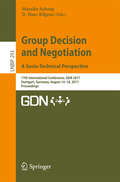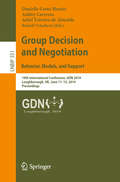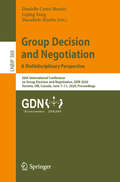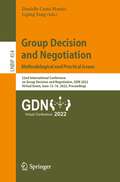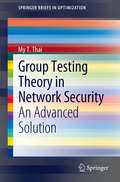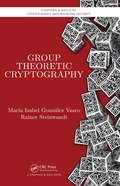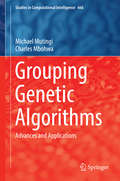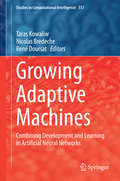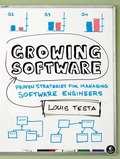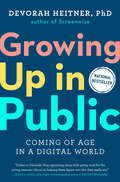- Table View
- List View
Group Decision and Negotiation in the Era of Multimodal Interactions: 23rd International Conference on Group Decision and Negotiation, GDN 2023, Tokyo, Japan, June 11–15, 2023, Proceedings (Lecture Notes in Business Information Processing #478)
by Pascale Zaraté Liping Fang Masahide Horita Yu MaemuraThis book constitutes the refereed proceedings of the 23rd International Conference on Group Decision and Negotiation, GDN 2023, which took place in Tokyo, Japan during June 11–15, 2023.The field of Group Decision and Negotiation focuses on decision processes with at least two participants and a common goal but conflicting individual goals. Research areas of Group Decision and Negotiation include electronic negotiations, experiments, the role of emotions in group decision and negotiations, preference elicitation and decision support for group decisions and negotiations, and conflict resolution principles. This year’s conference focusses on multimodal interactions. The 11 full papers presented in this volume were carefully reviewed and selected from 102 submissions. They were organized in the following topical sections: Taking a step back: Critically re-examining technology interactions with group decision and negotiation; preference modeling and multi-criteria decision-making; and conflict modeling and distributive mechanisms.
Group Decision and Negotiation. A Socio-Technical Perspective: 17th International Conference, GDN 2017, Stuttgart, Germany, August 14-18, 2017, Proceedings (Lecture Notes in Business Information Processing #293)
by D. Marc Kilgour Mareike SchoopThis book constitutes the refereed proceedings of the 17th International Conference on Group Decision and Negotiation, GDN 2017, held in Stuttgart, Germany, in August 2017. The field of Group Decision and Negotiation focuses on decision processes with at least two participants and a common goal but conflicting individual goals. Research areas of Group Decision and Negotiation include electronic negotiations, experiments, the role of emotions in group decision and negotiations, preference elicitation and decision support for group decisions and negotiations, and conflict resolution principles.The 14 full papers presented in this volume were carefully reviewed and selected from 87 submissions. They were organized in topical sections named: general topics in group decision and negotiation; conflict resolution; emotions in group decision and negotiation; negotiation support systems and studies; and preference modeling for group decision and negotiation. The book also contains two invited talks in full paper length.
Group Decision and Negotiation: 19th International Conference, GDN 2019, Loughborough, UK, June 11–15, 2019, Proceedings (Lecture Notes in Business Information Processing #351)
by Adiel Teixeira de Almeida Rudolf Vetschera Danielle Costa Morais Ashley CarrerasThis book constitutes the refereed proceedings of the 19th International Conference on Group Decision and Negotiation, GDN 2019, held in Loughborough, UK, in June 2019. The field of Group Decision and Negotiation focuses on decision processes with at least two participants and a common goal but conflicting individual goals. Research areas of Group Decision and Negotiation include electronic negotiations, experiments, the role of emotions in group decision and negotiations, preference elicitation and decision support for group decisions and negotiations, and conflict resolution principles. The 17 full papers presented in this volume were carefully reviewed and selected from 98 submissions. They were organized in topical sections named: preference modeling for group decision and negotiations; collaborative decision making processes; conflict resolution; behavioral OR, and negotiation support systems and studies.
Group Decision and Negotiation: 20th International Conference on Group Decision and Negotiation, GDN 2020, Toronto, ON, Canada, June 7–11, 2020, Proceedings (Lecture Notes in Business Information Processing #388)
by Liping Fang Danielle Costa Morais Masahide HoritaThis book constitutes the refereed proceedings of the 20th International Conference on Group Decision and Negotiation, GDN 2020, which was planned to be held in Toronto, ON, Canada, during June 7–11, 2020. The conference was cancelled due to the Coronavirus pandemic. Nevertheless, it was decided to publish the proceedings, because the review process had already been completed at the time the cancellation was decided. The field of Group Decision and Negotiation focuses on decision processes with at least two participants and a common goal but conflicting individual goals. Research areas of Group Decision and Negotiation include electronic negotiations, experiments, the role of emotions in group decision and negotiations, preference elicitation and decision support for group decisions and negotiations, and conflict resolution principles. The 14 full papers presented in this volume were carefully reviewed and selected from 75 submissions. They were organized in topical sections named: Conflict Resolution, Preference Modeling for Group Decision and Negotiation, Intelligent Group Decision Making and Consensus Process, Collaborative Decision Making Processes.
Group Decision and Negotiation: 22nd International Conference on Group Decision and Negotiation, GDN 2022, Virtual Event, June 12–16, 2022, Proceedings (Lecture Notes in Business Information Processing #454)
by Liping Fang Danielle Costa MoraisThis book constitutes the refereed proceedings of the 22nd International Conference on Group Decision and Negotiation, GDN 2022, which was held virtually during June 12–16, 2022. The field of Group Decision and Negotiation focuses on decision processes with at least two participants and a common goal but conflicting individual goals. Research areas of Group Decision and Negotiation include electronic negotiations, experiments, the role of emotions in group decision and negotiations, preference elicitation and decision support for group decisions and negotiations, and conflict resolution principles. This year’s conference focusses on methodological and practical issues. The 9 full papers presented in this volume were carefully reviewed and selected from 68 submissions. They were organized in the following topical sections: Preference modeling for group decision and negotiation; conflict resolution; collaborative decision making processes.
Group Policy
by Jeremy MoskowitzThe Ultimate Book on Group Policy Freshly updated to include Windows 7, Windows 8 and Windows Server 2012, Group Policy: Fundamentals, Security, and the Managed Desktop, Second Edition is the book for learning everything you need to know about Group Policy, no matter which version of Windows you use. Microsoft Group Policy MVP Jeremy Moskowitz covers it all--major Group Policy categories, what Windows 8 and Windows Server 2012 bring to the table, and smart ways to tackle tough desktop management problems. Topics include troubleshooting, security, scripting, using Windows PowerShell when necessary, and much more. Inside this book, you'll learn to: Master all Group Policy functions of Windows, including Windows XP through Windows 8 and Windows Server 2003 through Windows Server 2012 Enhance your Group Policy reach with the Group Policy Preferences, ADMX files, and additional add-ons Use every feature of the GPMC and become a top-notch administrator Troubleshoot Group Policy using tools, logs, Resource Kit utilities, Registry hacks, and third-party tools Manage printers, restrict hardware, and configure Internet Explorer Deploy software to your desktops, set up roaming profiles, and configure Offline Files for all your Windows clients--and manage it all with Group Policy settings Secure your desktops and servers with AppLocker, Windows Firewall with Advanced Security, and the Security Configuration Manager Download bonus chapters and: Script complex GPMC operations with PowerShell, including linking, backup, restore, permissions changes, and more Create a "change management" system with Advanced Group Policy Management (AGPM v4) Understand Windows Intune service and its relationship to Group Policy Coverage Includes: Updated GPMC New Windows 8 GPMC Features ADMX/ADML Files Group Policy Preferences Item-Level Targeting The Central Store AppLocker Fine-Grained Password Policy Offline Files Updates Inheritance Blocking Prioritization Linking Loopback Policy Processing Security Policy Processing Enforcing WMI Filters Third-Party Tools Cross-Forest Trusts Filters Commenting Searching Advanced Logging and Troubleshooting Advanced Auditing Controls Group Policy and VDI Security Configuration Manager Windows Intune
Group Policy: Fundamentals, Security, and the Managed Desktop
by Jeremy MoskowitzThe Ultimate Book on Group Policy Freshly updated to include Windows 7, Windows 8 and Windows Server 2012, Group Policy: Fundamentals, Security, and the Managed Desktop, Second Edition is the book for learning everything you need to know about Group Policy, no matter which version of Windows you use. Microsoft Group Policy MVP Jeremy Moskowitz covers it all—major Group Policy categories, what Windows 8 and Windows Server 2012 bring to the table, and smart ways to tackle tough desktop management problems. Topics include troubleshooting, security, scripting, using Windows PowerShell when necessary, and much more. Inside this book, you'll learn to: Master all Group Policy functions of Windows, including Windows XP through Windows 8 and Windows Server 2003 through Windows Server 2012 Enhance your Group Policy reach with the Group Policy Preferences, ADMX files, and additional add-ons Use every feature of the GPMC and become a top-notch administrator Troubleshoot Group Policy using tools, logs, Resource Kit utilities, Registry hacks, and third-party tools Manage printers, restrict hardware, and configure Internet Explorer Deploy software to your desktops, set up roaming profiles, and configure Offline Files for all your Windows clients—and manage it all with Group Policy settings Secure your desktops and servers with AppLocker, Windows Firewall with Advanced Security, and the Security Configuration Manager Download bonus chapters and: Script complex GPMC operations with PowerShell, including linking, backup, restore, permissions changes, and more Create a "change management" system with Advanced Group Policy Management (AGPM v4) Understand Windows Intune service and its relationship to Group Policy Coverage Includes: Updated GPMC New Windows 8 GPMC Features ADMX/ADML Files Group Policy Preferences Item-Level Targeting The Central Store AppLocker Fine-Grained Password Policy Offline Files Updates Inheritance Blocking Prioritization Linking Loopback Policy Processing Security Policy Processing Enforcing WMI Filters Third-Party Tools Cross-Forest Trusts Filters Commenting Searching Advanced Logging and Troubleshooting Advanced Auditing Controls Group Policy and VDI Security Configuration Manager Windows Intune
Group Processes
by Marshall Scott Poole Andrew PilnyThis volume introduces a series of different data-driven computational methods for analyzing group processes through didactic and tutorial-based examples. Group processes are of central importance to many sectors of society, including government, the military, health care, and corporations. Computational methods are better suited to handle (potentially huge) group process data than traditional methodologies because of their more flexible assumptions and capability to handle real-time trace data. Indeed, the use of methods under the name of computational social science have exploded over the years. However, attention has been focused on original research rather than pedagogy, leaving those interested in obtaining computational skills lacking a much needed resource. Although the methods here can be applied to wider areas of social science, they are specifically tailored to group process research. A number of data-driven methods adapted to group process research are demonstrated in this current volume. These include text mining, relational event modeling, social simulation, machine learning, social sequence analysis, and response surface analysis. In order to take advantage of these new opportunities, this book provides clear examples (e. g. , providing code) of group processes in various contexts, setting guidelines and best practices for future work to build upon. This volume will be of great benefit to those willing to learn computational methods. These include academics like graduate students and faculty, multidisciplinary professionals and researchers working on organization and management science, and consultants for various types of organizations and groups.
Group Recommender Systems: An Introduction (Signals and Communication Technology)
by Alexander Felfernig Marko Tkalčič Ludovico Boratto Martin StettingerThis book discusses different aspects of group recommender systems, which are systems that help to identify recommendations for groups instead of single users. In this context, the authors present different related techniques and applications. The book includes in-depth summaries of group recommendation algorithms, related industrial applications, different aspects of preference construction and explanations, user interface aspects of group recommender systems, and related psychological aspects that play a crucial role in group decision scenarios.
Group Recommender Systems: An Introduction (Springerbriefs In Electrical And Computer Engineering)
by Alexander Felfernig Marko Tkalčič Ludovico Boratto Martin StettingerThis book presents group recommender systems, which focus on the determination of recommendations for groups of users. The authors summarize different technologies and applications of group recommender systems. They include an in-depth discussion of state-of-the-art algorithms, an overview of industrial applications, an inclusion of the aspects of decision biases in groups, and corresponding de-biasing approaches. The book includes a discussion of basic group recommendation methods, aspects of human decision making in groups, and related applications. A discussion of open research issues is included to inspire new related research. The book serves as a reference for researchers and practitioners working on group recommendation related topics.
Group Sequential and Confirmatory Adaptive Designs in Clinical Trials (Springer Series in Pharmaceutical Statistics)
by Gernot Wassmer Werner BrannathThis book provides an up-to-date review of the general principles and techniques of confirmatory adaptive designs, a generalization of group sequential designs. With these designs, interim analyses are performed in order to stop a trial prematurely under control of the Type I error rate. In adaptive designs, it is also permissible to perform a data-driven change of relevant aspects of the study design at interim stages. This includes, for example, a sample-size reassessment, a treatment-arm selection, or a selection of a pre-specified sub-population.First introduced in the 1990s, this popular adaptive methodology has become the focus of intense discussion and is still a rapidly growing field of statistical research. The book describes adaptive design methodology at an elementary level, while also considering design and planning issues. It also looks at methods for analyzing an adaptively planned trial, such as estimation methods and methods for determining an overall p-value. Part I provides the group sequential preliminaries required to understand and apply the adaptive design methodology supplied in Parts II and III. Many examples are included that illustrate the practical applications of the techniques. An overview of recent developments is given and, new to this edition, detailed descriptions of the R commands used for the calculations are provided. The R package rpact, which is available on CRAN, allows for the recalculation of most tables and results presented in the monograph. The required knowledge of R has been kept to a minimum, and an online Shiny app has been made available for rpact. Primarily written for applied statisticians from academia and industry who are interested in confirmatory adaptive designs, the text is also suitable for an advanced statistical course for applied statisticians or clinicians with a sound statistical background.
Group Testing Theory in Network Security
by My T. ThaiGroup Testing Theory in Network Security explores a new branch of group testing theory with an application which enhances research results in network security. This brief presents new solutions on several advanced network security problems and mathematical frameworks based on the group testing theory, specifically denial-of-service and jamming attacks. A new application of group testing, illustrated in this text, requires additional theories, such as size constraint group testing and connected group testing. Included in this text is a chapter devoted to discussing open problems and suggesting new solutions for various network security problems. This text also exemplifies the connection between mathematical approaches and practical applications to group testing theory in network security. This work will appeal to a multidisciplinary audience with interests in computer communication networks, optimization, and engineering.
Group Theoretic Cryptography (Chapman & Hall/CRC Cryptography and Network Security Series)
by Maria Isabel Gonzalez Vasco Rainer SteinwandtGroup theory appears to be a promising source of hard computational problems for deploying new cryptographic constructions. This reference focuses on the specifics of using groups, including in particular non-Abelian groups, in the field of cryptography. It provides an introduction to cryptography with emphasis on the group theoretic perspective, making it one of the first books to use this approach. The authors provide the needed cryptographic and group theoretic concepts, full proofs of essential theorems, and formal security evaluations of the cryptographic schemes presented. They also provide references for further reading and exercises at the end of each chapter.
Grouping Genetic Algorithms
by Charles Mbohwa Michael MutingiThis book presents advances and innovations in grouping genetic algorithms, enriched with new and unique heuristic optimization techniques. These algorithms are specially designed for solving industrial grouping problems where system entities are to be partitioned or clustered into efficient groups according to a set of guiding decision criteria. Examples of such problems are: vehicle routing problems, team formation problems, timetabling problems, assembly line balancing, group maintenance planning, modular design, and task assignment. A wide range of industrial grouping problems, drawn from diverse fields such as logistics, supply chain management, project management, manufacturing systems, engineering design and healthcare, are presented. Typical complex industrial grouping problems, with multiple decision criteria and constraints, are clearly described using illustrative diagrams and formulations. The problems are mapped into a common group structure that can conveniently be used as an input scheme to specific variants of grouping genetic algorithms. Unique heuristic grouping techniques are developed to handle grouping problems efficiently and effectively. Illustrative examples and computational results are presented in tables and graphs to demonstrate the efficiency and effectiveness of the algorithms. Researchers, decision analysts, software developers, and graduate students from various disciplines will find this in-depth reader-friendly exposition of advances and applications of grouping genetic algorithms an interesting, informative and valuable resource.
Grow Your Business with AI: A First Principles Approach for Scaling Artificial Intelligence in the Enterprise
by Francisco Javier Campos ZabalaLeverage the power of Artificial Intelligence (AI) to drive the growth and success of your organization. This book thoroughly explores the reasons why it is so hard to implement AI, and highlights the need to reconcile the motivations and goals of two very different groups of people, business-minded and technical-minded. Divided into four main parts (First Principles, The Why, The What, The How), you'll review case studies and examples from companies that have successfully implemented AI. Part 1 provides a comprehensive overview of the First Principles approach and its basic conventions. Part 2 provides an in-depth look at the current state of AI and why it is increasingly important to businesses of all sizes. Part 3 delves into the key concepts and technologies of AI. Part 4 shares practical guidance and actionable steps for businesses looking to implement AI. Grow Your Business with AI is a must-read for anyone looking to understand and harness the power of AI for business growth and to stay ahead of the curve. What You'll LearnReview the key concepts and technologies of AI, including machine learning, natural language processing, and computer visionApply the benefits of AI, including increased efficiency, improved decision-making, and new revenue streams in different industriesIntegrate AI into existing systems and processes.Who This Book Is ForEntrepreneurs, business leaders, and professionals looking to leverage the power of AI to drive growth and success for their organizations.
Growing Adaptive Machines
by Taras Kowaliw Nicolas Bredeche René DoursatThe pursuit of artificial intelligence has been a highly active domain of research for decades, yielding exciting scientific insights and productive new technologies. In terms of generating intelligence, however, this pursuit has yielded only limited success. This book explores the hypothesis that adaptive growth is a means of moving forward. By emulating the biological process of development, we can incorporate desirable characteristics of natural neural systems into engineered designs and thus move closer towards the creation of brain-like systems. The particular focus is on how to design artificial neural networks for engineering tasks. The book consists of contributions from 18 researchers, ranging from detailed reviews of recent domains by senior scientists, to exciting new contributions representing the state of the art in machine learning research. The book begins with broad overviews of artificial neurogenesis and bio-inspired machine learning, suitable both as an introduction to the domains and as a reference for experts. Several contributions provide perspectives and future hypotheses on recent highly successful trains of research, including deep learning, the Hyper NEAT model of developmental neural network design, and a simulation of the visual cortex. Other contributions cover recent advances in the design of bio-inspired artificial neural networks, including the creation of machines for classification, the behavioural control of virtual agents, the desi gn of virtual multi-component robots and morphologies and the creation of flexible intelligence. Throughout, the contributors share their vast expertise on the means and benefits of creating brain-like machines. This book is appropriate for advanced students and practitioners of artificial intelligence and machine learning.
Growing Software: Proven Strategies for Managing Software Engineers
by Louis Testa<P>As the technology leader at a small software company, you need to focus on people, products, processes, and technology as you bring your software to market, while doing your best to put out fires and minimize headaches. <P>Growing Software is your guide to juggling the day-to-day challenges of running a software company while managing those long-term problems and making sure that your business continues to grow. With practical, hands-on advice, Growing Software will teach you how to build and lead an effective team, define and sell your products, work with everyone from customers to CEOs, and ensure high-quality results.Instead of learning by trial and error, you'll benefit from author Louis Testa's 20+ years of management experience. Testa combines big-picture advice, specific solutions, and real-life anecdotes to teach you how to: <br>–Work effectively with your CEO and executive team <br>–Improve development team efficiency and enthusiasm <br>–Evaluate your software methodology to improve effectiveness and safeguard against failure <br>–Use product prototypes to bridge the gap between marketing and engineering <br>–Defuse technology time bombs <P>Whether you're new to managing software or newly lost, Growing Software will help you and your growing company thrive.
Growing Up Online
by Sandra Weber Shanly DixonIn this cutting-edge anthology, contributors examine the diverse ways in which girls and young womenacross a variety of ethnic, socio-economic, and nationalbackgroundsare incorporating and making sense of digital technology in their everyday lives. Contributors explore identity development, how young women interact with technology, and how race, class, and identity influence game play. "
Growing Up Shared: How Parents Can Share Smarter on Social Media-and What You Can Do to Keep Your Family Safe in a No-Privacy World
by Stacey SteinbergIs it okay to share details about my child's life on social media?What kinds of pictures should I avoid posting?Am I taking away my kids' ownership over their future online footprint?It has never been easier to share our lives online—from meals to selfies and relationship statuses to locations, information about our daily activities flows freely. But what about our right to share our kids' lives? In today's age of "sharenting", striking the right balance between engaging in online communities and respecting a child's privacy and safety can be difficult. In Growing Up Shared, Stacey Steinberg, law professor, mother, and expert on the intersection of social media and parenting, shares her insights. From her years of research, Steinberg outlines what parents should and should not feel comfortable sharing, while providing suggestions and ideas for a wide range of approaches, including:How we can benefit from sharing, and how screens can connect usThe dangers of oversharingHow to model behavior onlineThe difference in how parents and kids view online sharingThe importance of educating kids about technologyEngaging, approachable, and with concrete takeaways for today's parents, Growing Up Shared investigates the benefits and risks of sharing our kids' lives on social media, and will help any parent decide on the right path for their family to follow in the online world.
Growing Up With Technology: Young Children Learning in a Digital World
by Christine Stephen Lydia Plowman Joanna McPakeGrowing Up with Technology explores the role of technology in the everyday lives of three- and four-year-old children, presenting the implications for the children’s continuing learning and development. Children are growing up in a world where the internet, mobile phones and other forms of digital interaction are features of daily life. The authors have carefully observed children’s experiences at home and analysed the perspectives of parents, practitioners and the children themselves. This has enabled them to provide a nuanced account of the different ways in which technology can support or inhibit learning. Drawing on evidence from their research, the authors bring a fresh approach to these debates, based on establishing relationships with children, families and educators to get insights into practices, values and attitudes. A number of key questions are considered, including: Which technologies do young children encounter at home and preschool? What kind of learning takes place in these encounters? How can parents and practitioners support this learning? Are some children disadvantaged when it comes to learning with technology? Growing Up with Technology is strongly grounded in a series of research projects, providing new ways of thinking about how children’s learning with technology can be supported. It will be of great interest to undergraduate and postgraduate students on a range of courses including childhood studies, and those with a particular interest in the use of technology in education. Parents, practitioners and researchers will also find this a fascinating and informative read.
Growing Up in Public: Coming of Age in a Digital World
by Devorah HeitnerThe definitive book on helping kids navigate growing up in a world where nearly every moment of their lives can be shared and comparedNATIONAL BESTSELLER With social media and constant connection, the boundaries of privacy are stretched thin. Growing Up in Public shows parents how to help tweens and teens navigate boundaries, identity, privacy, and reputation in their digital world. We can track our kids&’ every move with apps, see their grades within minutes of being posted, and fixate on their digital footprint, anxious that a misstep could cause them to be &“canceled&” or even jeopardize their admission to college. And all of this adds pressure on kids who are coming of age immersed in social media platforms that emphasize &“personal brand,&” &“likes,&” and &“gotcha&” moments. How can they figure out who they really are with zero privacy and constant judgment? Devorah Heitner shows us that by focusing on character, not the threat of getting caught or exposed, we can support our kids to be authentically themselves. Drawing on her extensive work with parents and schools as well as hundreds of interviews with kids, parents, educators, clinicians, and scholars, Heitner offers strategies for parenting our kids in an always-connected world. With relatable stories and research-backed advice, Growing Up in Public empowers parents to cut through the overwhelm to connect with their kids, recognize how to support them, and help them figure out who they are when everyone is watching.
Growing with Technology (Level #2)
by Gary B. Shelly Thomas J. Cashman Rachel Biheller BuninGrowing with Technology introduces elementary-aged children to the basics of computers and computer applications. The texts are organized into eight chapters that cover: Computer Foundations, Keyboarding, Word Processing, Networks and the Internet, Creating Graphics, Presentation Software, Spreadsheets and Databases.
Growing with Technology (Level #3)
by Gary B. Shelly Thomas J. Cashman Rachel Biheller BuninThe computing fundamentals program is designed to prepare elementary students for a future using technology.
Growing with Technology (Level #4)
by Gary B. Shelly Thomas J. Cashman Rachel Biheller BuninGrowing with Technology introduces elementary-aged children to the basics of computers and computer applications. The texts are organized into eight chapters that cover: Computer Foundations, Keyboarding, Word Processing, Networks and the Internet, Creating Graphics, Presentation Software, Spreadsheets and Databases.
Growing with Technology (Level #5)
by Gary B. Shelly Thomas J. Cashman Rachel Biheller BuninThe computing fundamentals program is designed to prepare elementary students for a future using technology.

